Rescuing Diskmags: Towards Scholarly [Re]Digitisation of an Early Born-Digital Heritage
Abstract Disk magazines are a special type of periodical that was published on floppy disk mainly in the 1980s and 1990s. Created by home computer enthusiasts for the community, disk magazines are potentially valuable as a historical resource to study the experiences of programmers, users and gamers in the early stage of microcomputing. The material preserved by fan communities could be a starting point to derive scientifically reliable resources. Creating a digital scholarly edition from the material needs not only to consider the original encoding and hardware standards, but also include the necessary role of emulation and hardware preservation.
Keywords Disk magazines. Digitisation. Digital scholarly edition. Home computers. Demoscene. Gaming. TEI. Annotation.
1 The Early Days
Some may still remember the decades when the first microcomputers settled in our living rooms and working places. In the decline of arcade and video games, it was devices from companies like Acorn, Atari, Commodore, Olivetti, Schneider/Amstrad, Sinclair – just to name a few – which defined the 1980s as a pioneering era of personal computing in the western hemisphere. Early personal computers did not only begin to replace typewriters and calculators in offices, but they were also introduced as recreational gaming platforms. Their omnipresence produced grassroots movements like the international demoscene as well as underground cracking groups, some of them remaining active for decades or even until today. However, this era and its memories are fading into temporal distance, and its devices, digital objects and human witnesses have begun to disappear. As seen from today, digital culture has changed and diversified considerably in comparison to then.
Early digital culture was strongly defined by the hardware, whose ergonomic accents created a typical ‘look and feel’, and confined the capacities of the respective devices in characteristic ways, as through available sound channels, colour palettes or screen resolutions, or even through specific peripheral ports. Further, the devices were not as hermetically sealed as they are today, so that they could be ‘hacked’ with little more than a soldering rod. On the software side, user interface intuitiveness depended much on input devices like keyboards and joysticks, and was perceived much differently from today. Some programs strongly depended on printed manuals. Magazines published program listings that were laboriously manually typed in. Nevertheless, despite this relatively hybrid state between analogue and digital components, people were willing to engage intensively in the devices and the programs and to creatively explore the possibilities under much limited circumstances again and again. How can this culture of the early digital movement still be conveyed today? Which sources do still exist? It is only a question of time until the remembrance of the original experiences fall into oblivion, together with the electronic and digital objects.
It is a good moment to take action. Archivists, librarians and museologists on the one side and fan communities on the other side have already begun to preserve digital material from the first decades of home computing and gaming culture. More recently, multiple humanities research groups have initiated their research to develop an understanding of the social and historical relevance of that period. Indeed the experience of the early microcomputing scene has become rather unfamiliar to us today: pixelated, crudely coloured objects and low quality audio effects, together with very individual interfaces developed for the respective devices, no in-game help and usually printed manuals. While some of these visual and auditive characteristics have transformed into elements of an 8-bit retro culture, the original user experience of that time is far from being documented with a similar density and mediality as today’s gaming scene does by Let’s Plays, walkthroughs, fandom wikis and social media channels.
While the vast majority of games distributed at that time have survived as executable software and can be recreated in emulators today, there is a noticeable lack when it comes to sources that can actually serve as documents of historical user experiences. While contemporary witnesses could be one starting point, there is still some digital material from that time that has electronically survived. Most of it has not yet been made accessible according to scientific digital humanities standards, and it should be worth the effort.
2 What Were Disk Magazines?
2.1 General Characteristics
This article is about a medium that emerged in the early digital culture period and provides characteristic documents for this period. Disk magazines – also called ‘diskmags’, ‘diskzines’ or ‘magazette’ – represent a special type of magazine for use on personal computers, which was published exclusively on digital media, such as data tapes, 5¼-inch and 3½-inch floppy disks or CD-ROMs.1 While it was not unusual for print magazines to include media devices as ‘covermount’, a speciality of disk magazines was that their main content was on the disk itself and not in the printed paper. In this sense, despite their hybrid character, they are an early born-digital resource (cf. the discussion in Ruan, McDonough 2009, 746).
1 Examples for ‘cassette magazines’, which were distributed in the late 1970s, are CURSOR for the Radio Shack TRS-80 and CLOAD for the Commodore PET.
The historical peak in the distribution and usage of disk magazines can be dated roughly to the late 1980s and early 1990s. They were primarily produced in countries with a relatively high density of devices, as in the United States, United Kingdom, West Germany, Italy, Sweden, Finland and other countries. The situation for disk magazines varied depending on the digitisation and on the computer companies’ market shares in the respective countries.2 Wikipedia (2022a) lists about 200 titles from that time; however, the yet incomplete list needs to be taken with a grain of salt. Most of the disk magazines were in English, but there was also a relevant German-speaking diskmag community – mostly outside of the GDR – with an estimated 30 magazines regularly distributed on floppy disk (cf. the list by Gansberger s.d.). Also a smaller number of Spanish, Dutch, Russian, Polish and Italian language disk magazines existed.3
2 In France, the online service Minitel successfully served as information interchange infrastructure in the 1980s and 1990s, which possibly limited the market for French disk magazines.
3 The diskmag collection of the Internet Archive (2015) presents a relevant number of Dutch issues.
Reading a disk magazine was only possible on the specific computer system it was designed for, so the potential audience was confined to the owners of those devices. Popular titles of the time were: Softdisk, the first disk magazine in 1981 for Apple II, initially published on data tape, and later ported for other systems; Loadstar for the Commodore 64, which set a record by existing until 2007; Daskmig for IBM-PC; Generation for the Amiga; and ST News for the Atari ST, just to name a few. Bertuca and Bertuca (1986) give a contemporary discussion of disk magazines as a new media and present a few titles. Most of them were sold in regular newspaper shops for pocket money, with a relevant secondary readership, while others were distributed only by copying. During the 1990s, when the World Wide Web became the primary media for information interchange, most disk magazines ceased or migrated to online platforms, sometimes keeping ‘disk magazine’ in their title.
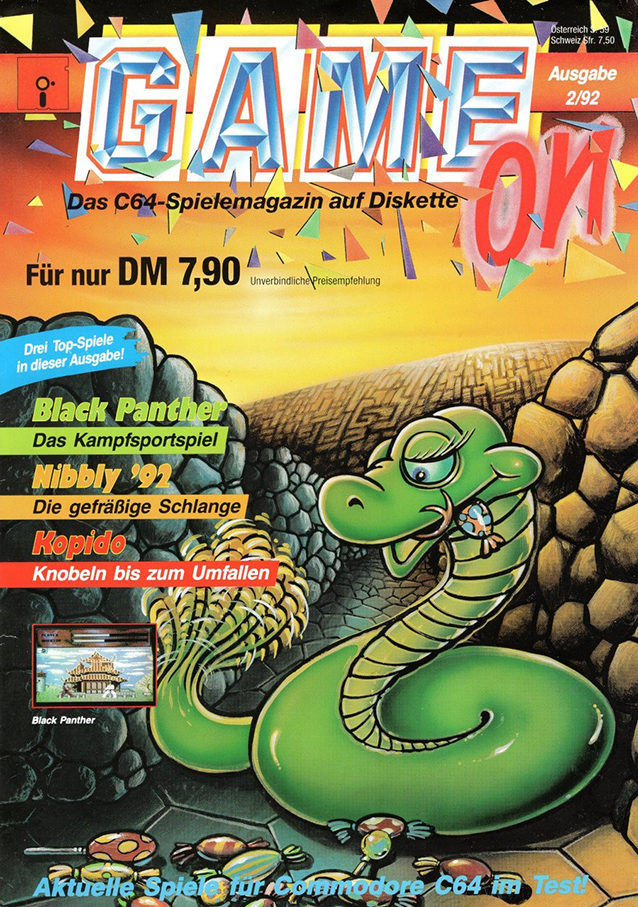
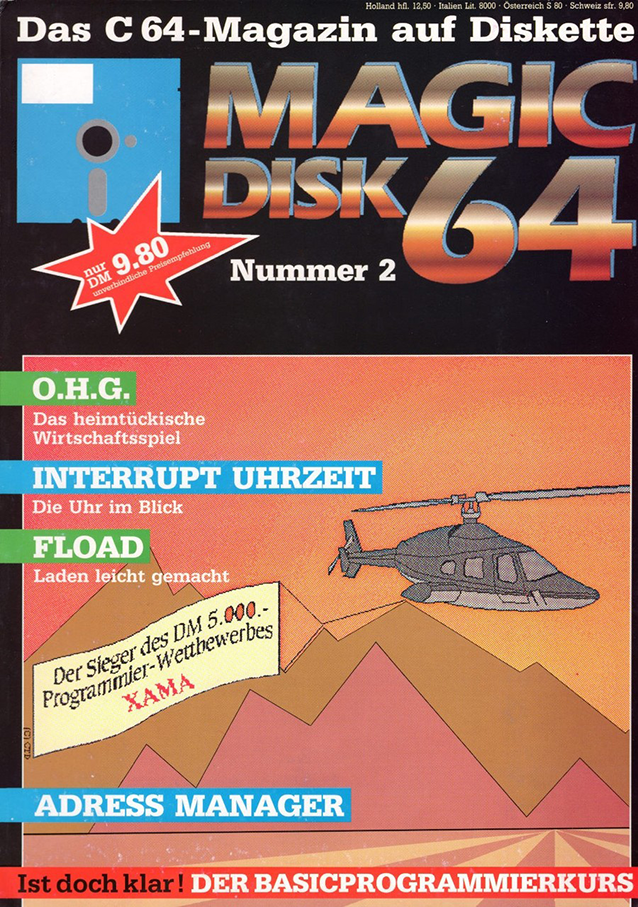
Figures 1a-b Paper covers of two German disk magazines from (a) Magic Disk 64, no. 2, 1989 and (b) Game On, no. 2, 1992. Source: c64-wiki.de. License: GNU Free Documentation License
One of these magazines should serve here and in the following chapters as an example. The popular German disk magazine Magic Disk 64, edited by Christian Geltenpoth, existed from 1987 to 1993 and was published monthly by CP Computer Publications GmbH in Nuremberg (cf. C64 Wiki 2015). It was distributed in regular shops at a moderate price of 9,80 DM (roughly 10 euro today) and was delivered on cardboard together with a coloured title page [figs 1a-b]. After 1993, it became included into the printed magazine Play Time and was eventually discontinued in 1995. The German magazine database contains only a record for the printed issues (cf. Zeitschriftendatenbank, s.d.).
2.2 Inside the Magazines
The content of the disk magazines was usually split into two sections. One side (sometimes literally – most floppy disks of the 5¼-inch generation stored data on both sides and had to be physically flipped) often contained articles written by authors from the home computing scene and covered current topics on microcomputers, peripherals, games, applications, hacking activities (both software and hardware) and the ongoing developments in the coder- and demoscene. The other part usually consisted of free software like applications, demos and games.

Figure 2 Section “Hardware” from Magic Disk 64, no. 11, 1987. Translation: “In the ‘Hardware’ category, we reveal what is happening in the hardware sector. Of course, we also present new developments, but also products that have stood the test of time in use with the C64. | This month is about: | BTX + C64 and the ETB … page 2 | 24-needle printer … page 4 | Voice Master … page 12”. Source: Screenshot from VICE Emulator
The articles of the disk magazines were rendered by a display software, which was programmed individually by the magazine teams and was included on the floppy disks. Essentially, disk magazines were executable programs which were able to display text with a simple, yet efficient navigation interface [fig. 2]. In this respect, they differ fundamentally from the less popular ‘zines’, which were distributed as plain text ASCII files and mostly distributed through the USENET. Disk magazines could take some time to load into the computer memory, especially when they were stored in compressed data formats. A demonstration video by Klaus Rettinghaus (2020) shows an original setup in which it takes about 20 seconds to load the splash screen and another minute to load the main menu.

Figure 3 Bitmap graphic from Magic Disk 64, no. 11, 1987, creator unknown. Source: Screenshot from VICE Emulator
The general design of the disk magazines tended towards multimedia. Many articles were accompanied by block or bitmap graphics [fig. 3], moving text and sprite graphics, and sometimes even music was played in the background. The user interfaces were designed individually, with some peculiarities in their operating mode that seems sometimes not very intuitive from a today perspective: some depended exclusively on input devices like joysticks, others required the knowledge of customary keyboard commands.
It should also be mentioned that the disk magazines’ programmers were often their authors and editors at the same time. The creators of disk magazines were often individuals from the home computing community: coders, gamers, programmers, hobbyists, some of them surprisingly young. As an expression of a niche and underground subculture, many diskmag articles deliberately do not mimic the format, language and decorum of journalistic professionalism. Even when the magazines were distributed commercially, most of them maintained the flavour of a grassroots product, with an intermediate position between consumers and critics. In this respect, disk magazines could fill a gap in the historical records of early digitality, as they allow us to understand the structures, language and habitus of the home computer scene of that time.
3 Diskmags as Cultural Heritage
3.1 Potentials
Disk magazines may serve as an example of pre-WWW born-digital archive assets. They derive from a highly productive and creative decade of digital culture. Just in 2021, the German UNESCO chapter acknowledged the demoscene, which is closely related to the diskmags scene, as intangible cultural heritage (cf. Lange 2019; Deutsche UNESCO-Kommission 2021). Whether something similar will happen to disk magazines is up to its community, however the general awareness of digital culture as cultural heritage has definitely risen since UNESCO published its first charter on the preservation of digital cultural heritage (2009).
In practice, disk magazines are a very popular textual source that represent contemporary hubs for discussions about hardware, applications, games and demos apart from established printed magazines and early Internet services like USENET. They do not only document a subculture, but provide an important reference for comparisons as well. Potentially, disk magazines could reflect the development and evolution of a nerdy and multifaceted subculture of hackers, coders, users and gamers, which later became incorporated into a culture of digital mass-media, where some of its characteristic traits were picked up by the retro scene decades later. Last but not least, as a multimedia product, disk magazines are a part of the cultural heritage of their time itself, necessarily to be preserved as a whole, possibly together with their user experience.
3.2 Challenges
The preservation of these magazines and their compatible hard- and software ensembles is precarious. There is no reliable and comprehensive index of disk magazines that would offer a starting point for systematic research. Only a few libraries have randomly collected a fraction of issues, since disk magazines were not collected or archived systematically like print magazines. It must be assumed that some diskmag issues are already lost, and some titles forgotten.
As far as the materiality of the storage media is concerned, the magnetisation layer of floppy disks degrade over time and become unreadable after 10‑30 years, depending on data density (cf. National Semiconductor Corporation 1989, 30). Even if the original floppy disks are still readable, they would still require suitable devices in order to be read; a more reliable, hardware/software based preservation option is KryoFlux by the Software Preservation Society (2021).4 Also the hardware tends to deteriorate over time and would need to be repaired, replaced or reconstructed. Access through the original hardware, so it seems, needs to be limited to specific circumstances, e.g. bitstream preservation, museum exhibits and for creating documentaries, but probably not for doing research.
Emulation is a scenario which is better suited for mass access. They can serve as ‘facsimiles’, even if the original ‘look and feel’ of the hardware is strongly limited to what the emulation device can recreate. It requires bitstream copies of the original disks (cf. Barrera-Gomez, Erway 2013 for a generic guide). Luckily, diskmags have a very strong and active fanbase, and there are some online collections that provide the required binaries. For copyright implications, the collection and publication of these binaries is legally questionable, but if these issues can be resolved, these community-created collections would be the best starting point to create a systematic collection of diskmag binaries. Furthermore, the Internet Archive (2015) has stored some disk magazines and offers browser-based emulation; some issues are also available as ‘browse through’ videos on YouTube.
In the case of Magic Disk 64, there are many fan-based projects that have republished the contents of the magazine on the Internet. Floppy binaries are available on a website by Christian Zauner (2022), including scans of the original paper titles. A YouTube channel by Patrick Patul (2022) gives live comments while browsing through the pages. Another page provides an index with transcriptions and images (Nerdherrschaft 2008). Altogether, the preservation situation is good on some levels. However the legal status remains unclear, making re-use difficult even for scientific purposes.
3.3 Diskmags for Historical Research
While there can be debate in the context of preserving digital cultural heritage about how best to preserve the physical media on the one side while making it publicly available on the other side, I would like to expand here on the potential of disk magazines as a source for historical research. The numerous game reviews and commentaries provide a first-hand resource for investigations into contemporary gaming experiences and game reception, entanglements between user and hacker communities, and last but not least the early demoscene and computer art scene, just to name a few ideas. One thesis is that the magazines reveal both an increasing aesthetic expectation for visual and auditory design and the professionalisation of software criticism, which, however, much unlike the printed computer magazines of the time, has its origins in a grassroots movement. The dense network of references in the magazines – which programs and devices are chosen for review, how are they categorised, which are recurrently used as references – also offers the chance to conduct intermedial and linked data-based analyses. Last but not least, the material is linguistically interesting to study the subculture language of the computer scene.
While the community has already created some valuable online resources, these do not meet the requirements for a scientific approach in terms of searchability, reliability, citability and re-usability. The prerequisites for scientific investigations would consist in multiple levels of data services:
-
A reliable catalogue of titles and possibly also issues for all disk magazines.
-
Bitstream copies of the original disks need to be preserved and made accessible, which implies valid re-use licenses.
-
A digital text corpus that allows both close reading and distant reading, or in other words, both human- and machine-based analytic approaches, should be created by extracting text from the available bitstream copies.
-
This data could be enriched by NER (named entity recognition) processing or POS (part of speech) tagging. Named entities are interesting for systematic research and for creating authority records as reference points for libraries and the LOD (linked open data) cloud.
-
Disk magazines are a highly challenging subject for digital scholarly editions, as they pose a number of questions on the nature of historical sources and on digital textuality and materiality likewise. This results in tasks for processing and interpreting the original binaries, practically re-digitising them into a new presentation media. Such an edition would also require a persistent connection to documentaries of the original material and to emulated versions (like a facsimile) as well. Further, a scholarly edition would also require a critical commentary on the contents and on the text itself.
In the following section, I will focus on the fifth level, which comprises the complexity of the other four. A sixth level, which will be discussed only briefly here, is the intermediality of disk magazines, which comes by the numerous references in the texts to certain situations in games and applications. Many references to software are not resolvable without a proper ‘document’ of the original object. A simple solution is to link to screencast videos that replay the situation in the respective software. As demonstrated by Kaltman et al. (2021), it is also possible to create hyperlinks into specific memory states of emulated environments within the browser (also known as ‘save state’, ‘memory dump’ or ‘restore point’). This offers potential to not only resolve references through linking to catalogue entries, but to jump into reconstructed situations, e.g. in computer games or programming courses. This is especially interesting for the programs that were delivered together with the disk magazines, but also generally for textual references to software. This would require, however, an immense effort to create all those memory states – which could be a potential task for a citizen science project. However, there might be legal questions to resolve, depending on the copyright status of the referred software: not everything is yet ‘abandonware’ (the software is no longer supported or the creators are unknown) or ‘public domain’ (the creators deliberately waived copyright). From this complex legal situation, it should be assumed that software links would have to rely on more than one reference platform.
4 [Re]Digitisation
Creating a scholarly edition from 30‑40 years old digital material will likely have to deal with the contemporary encoding standards, with the original input and output devices and their relative limitations, as well as the digital aesthetics of that time. The following description of the required steps toward a re-digitisation is focused on text, but I will also tackle some aspects of image and sound conversion, as well as text-software-linking, which however would require separate skills and expertise.
4.1 Text Extraction
Assuming that a binary copy is available, it is likely that the data needs to be decompressed first. A number of native compression programs (‘crunchers’) existed, like MatchamSpeed and Sledgehammer for the Commodore 64 (cf. C64 Wiki 2017); however, it is possible that a magazine implemented their own compression algorithm. As an alternative, it is also possible to work with RAM captures from the emulator after the decompression procedure took place. From that, it should also be possible to deduce the respective compression algorithm.
Apart from the main text of the disk magazines, paratexts also should be identified and possibly included in the edition. Most disk magazines were distributed with a cover on printed paper as carrier media, some contained intro screens which were displayed before the actual magazine was loaded into memory. And last but not least, the directories of the original floppy disks should be considered paratexts, which can be extracted with programs like DirMaster.5
4.2 Text Conversion
The code then needs to be interpreted according to the original standards. While ASCII was accepted as a common ground, manufacturers often created their own extensions and modifications, like PETSCII by Commodore Business Machines (cf. Wikipedia 2022b). A one-to-one mapping to Unicode is in some cases impossible without utilising the Unicode custom area. Manual adjustments are often necessary and it would be required to document the mapping of the encodings. Further, it was customary to modify the default character sets in order to render diacritics, emojis, block graphics and other graphic symbols; some devices like Sinclair ZX Spectrum provided extra areas for user defined graphics. The variance is potentially endless: the character sets could also be modified for composing larger images, which makes it questionable if digital text can actually be interpreted as literal text instead of being interpreted as the image it is meant to present.
4.3 Text Interpretation
Assuming that the text can be successfully extracted from the source files, it needs to be interpreted according to the visible typography. For some markup features, technical compromises had to be made in order to create a layout that satisfied a certain level of typographic aesthetics [fig. 4]. Computer text was usually strictly grid-based; e.g. on Commodore 64 machines it was 25 lines of 40 characters. Text alignment, to give one example, was implemented by white space; highlighting was limited to changing the text or background colour (no italics / bold, but inverting was customary) and to spacing, and it was common to create underlining by putting dashes or hyphens in the line below. Box graphics were frequently used, e.g. to highlight titles and important information. While each single character on the grid can be preserved byte-wise, it requires a markup layer to record the assumed intention or usage of the characters, as they need to be interpreted not only literally, but also visually.
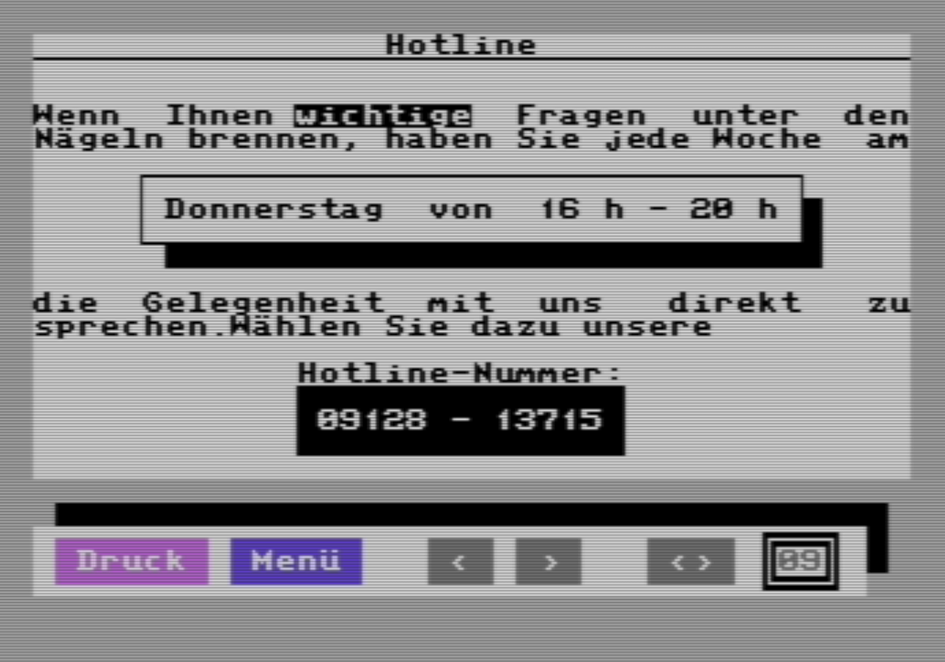
Figure 4 Example for block based typography, top area: white space centred text, underline with block graphics; first paragraph: inverted text and white space justification; below: centred boxes with shadow effect and inversion, bottom: box graphics GUI. Translation: “Hotline | If you have important questions, you have the opportunity to talk to us directly every week on | Thursday from 4‑8 pm | To do so, dial our | hotline number: | 09128 – 13715” (bold added to indicate highlighted or boxed text). Source: Magic Disk 64, no. 11, 1987. Screenshot from VICE Emulator
4.4 Image and Audio Conversion
Conversion of images and audio created originally on 8-bit devices share the specific trait of a relatively strong boundness to the original hardware and their historical standards.
Colour schemes were not necessarily based on RGB triplets, but some devices, like the Commodore 64, relied on the YUV scheme, which was used in NTSC and PAL television standards. This is evidently because home computers were meant to use home TVs as displays, and YUV is also backwards compatible to black-and-white devices, while RGB is not. In the YUV scheme, Y stands for non-linear brightness and U/V for blue and red luminance retrospectively, which can be converted only approximately, even if closely, into RGB (cf. Wikipedia 2022c).
Additionally, pixels on the typical CRT (cathode ray tube) monitors had a different shape compared to today’s LCDs (liquid crystal displays). Instead of a rectangular form, a CRT pixel resembles the form of a blob with soft edges, which also overlapped and merged with the adjacent pixels (cf. Smith 1995; see figs 5a-b for an example). While a digital image can be preserved by its original bitstream, its code does not automatically reproduce the original pixel shape. It will be required to apply an appropriate filter (Gaussian, in this case) to mimic the original CRT effect. Some emulators like VICE do support such filters [fig. 5a].
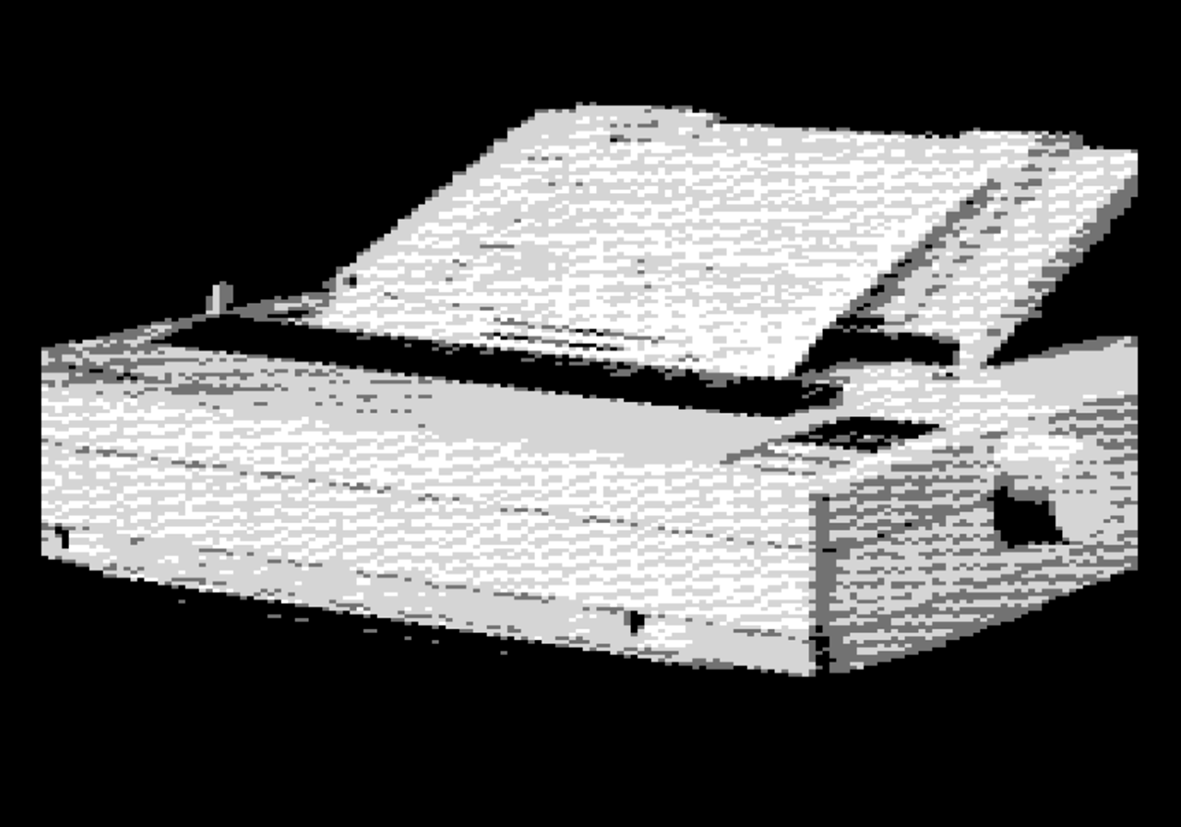

Figures 5a-b Comparison of the same digital image (a) on a CRT display and (b) on an LCD. Source: Magic Disk 64, no. 11, 1987. Screenshots from VICE Emulator
Apart from block graphics and bitmap graphics, many home computers supported ‘sprites’, which were smaller overlay images, intended mostly for moving elements on the screen (e.g. mouse pointers). They were frequently used in games and demos, but sometimes also for small dynamic graphics. The conversion procedure is comparable to bitmap graphics, however animation can come into play, which makes sprite graphics a feature that can probably be best experienced in an emulated setting instead of within a digital scholarly edition.
While image extraction and conversion is already challenging, audio extraction is more complex. The manufacturers often had peculiar approaches for the audio output of their devices and computer sound was strongly hardware dependent, as demonstrated by Rettinghaus (2018) for the C64 and Lizzy et al. (1984) for the BBC Micro. Apart from hardware exploits (see e.g. Rettinghaus 2020 on speech synthesis in computer games), algorithmic sound programming was used for creating loops, repetitions and special effects. While it might be possible to extract the data feed for the audio channel, it is difficult to interpret it without the original hardware. It may be the best option in many cases to preserve the music through recordings. Recordings from emulators seem possible as long as the emulation is capable of mimicking the original hardware – more like a simulation – together with all possible glitches that might have been used. There are already huge collections of media from the early home computing era, e.g. the High Voltage SID Collection (2022)6 for the Commodore 64, which could serve as one reference point.
4.5 Scholarly Annotation
The last stage of the re-digitisation process would consist in scholarly annotation layers. Usually this starts with checking the original text for orthographic consistency and flagging possible mistakes. The converted articles should be arranged according to their original sections and, if it makes sense, semantic elements like paragraphs and headings should be marked up. If the original text is based on page (screen) breaks, the page numbers should be documented for citability. However, the material is not necessarily arranged in a linear order.
A second scholarly annotation layer in digital scholarly editions usually covers named entities in a source, like persons, places and things, which can be created with help from NER scripts. Named entities are crucial for the study of disk magazines, as they can be utilised to find references for entities in more than one issue or magazines. It should be considered not to confine the entity types to places and persons (as in classical editions), but extend the entity types to software titles (application and games), programming languages, devices (computers and peripherals), manufacturers, and finally to names of the numerous developer, hacker, cracker and demo groups. It will be difficult to find authority records or at least linkable open data sets for these, as libraries do not offer much in this area, however there are some possible points of reference in community-based resources, like records for computer games in Wikidata.
A third scholarly annotation layer would provide commentaries on the original text, e.g. to explain technical terms, identify quotations and check for mistakes. This can be crucial for the understanding of the text, especially for those readers who do not have a background in the early home computer scene.
5 Demo Edition
In this chapter, I will demonstrate how a re-digitisation of an original disk magazine issue could look like in a TEI-XML (Text Encoding Initiative XML Schema) based environment. It is an attempt to make a disk magazine readable online with simple means and to make the text available for digital research.
I rebuilt the first issue of Magic Disk 64 (no. 11, 1987) with TEI-XML and created an HTML output through an XSL transformation. The data is available at GitHub (Roeder 2022a), while the demo edition is available under the corresponding GitHub Pages (Roeder 2022b). In the re-digitisation process, several decisions had to be made regarding technical environment, layout, character encoding, and mapping into TEI-XML. It remains to discuss whether the TEI guidelines yet provide a suitable standard for encoding a born-digital resource after all – or whether it would require substantial extensions or even another standard.
5.1 General Transformation Concept
I decided to move away from the idea to mimic the original page based user interface in all its details, which actually works more authentically and more convincingly in the emulator [fig. 6a]. It was my approach instead to put the whole content of one issue on a single HTML page [fig. 6c]. The articles are ordered according to their sequence in the original disk directory. To substitute the original navigation elements I have inserted hyperlinks in several places. For a better reading experience, I removed original line and page breaks, but kept them in the page margin for documentation (fig. 6c, top left). It was also considered to include links to screenshots from the original disk magazine, but yet not implemented: this will be discussed further in the following chapter on software references.
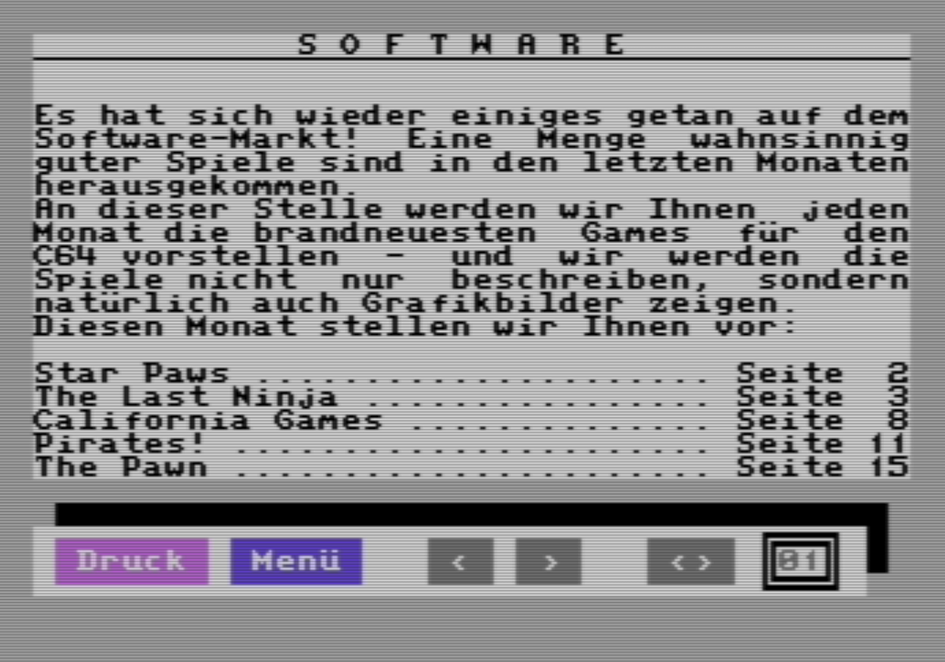
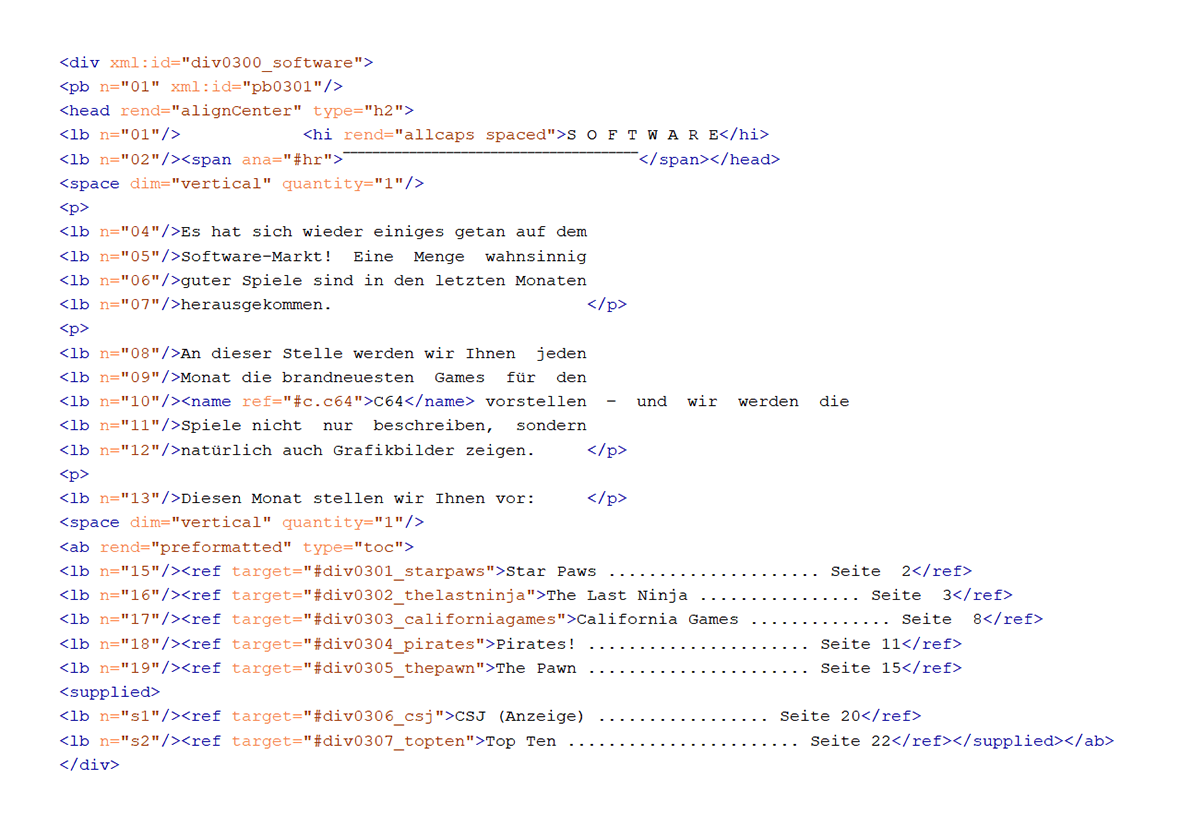

Figures 6a-c Section “Software”, Magic Disk 64, no. 11, 1987, p. 1 (a) in VICE Emulator, (b) encoded in TEI-XML, (c) rendered HTML output in the browser
The encoding maintains the original byte sequence including whitespace [fig. 6b]. It would be possible to reconstruct the original block-based layout [fig. 6a] from this, however I decided to use an equidistant font only when the block-based layout was characteristic or strictly necessary for the layout, and a serif font for normal paragraphs [fig. 6c]. This creates new line breaks, while the original line breaks are preserved in the TEI encoding.
The C64 charset was modified to represent German umlauts, so some of the characters needed to be mapped to UTF-8. Special characters were transferred with the best possible equivalent in Unicode, which in this case was possible without ambiguities. Finally, I have used a colour palette close to the original, and pixel precise images of the original graphics, however with no filter applied. Background music is not present in this issue.
Concerning paratexts, there is a colour printed title page for display in newspaper shops [figs 1a-b], which needs to be transcribed (diplomatically) and linked to the contents in the issue. Second, the complete directory of the floppy [fig. 7a] needs to be documented. Third, there is a startup screen [fig. 7b] with some basic instructions for the usage, which should also be included in the TEI. The front matter and back matter elements seem suited to bear these contents.

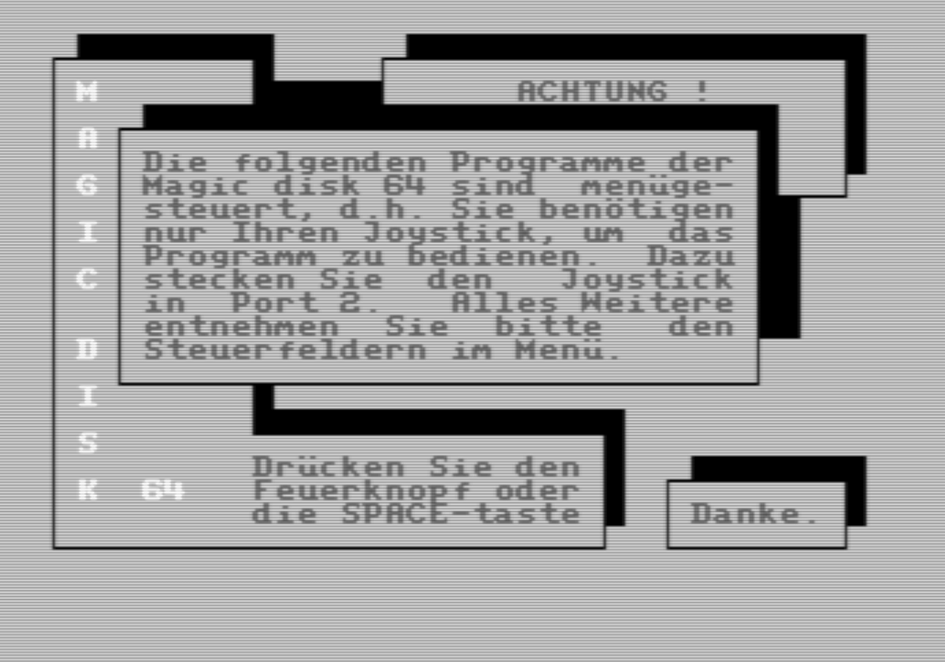
Figures 7a-b Two examples for paratexts: (a) partial directory listing of the a-side of a floppy disk and (b) splash screen with usage instructions. Source: Screenshot from VICE Emulator
5.2 Indexes, Commentary, Software References
I also tried to create an index of named entities in order to build up a reference system for a larger corpus of articles and issues. The problems begin with the authors of the texts, if they can be identified at all, who were sometimes known by one or possibly several pseudonyms in the scene. Then there are hacker, cracker and demo groups, where numerous overlaps in personnel are to be expected. This continues with titles of software (for applications and games) and their developers and extends to device names, both of computers and peripherals, and their manufacturing companies. For a part of this, a possible reference system is already provided by Wikidata, but not yet by national libraries. In the end, the general topography of entity references in disk magazines is completely different from that we can expect from historical prints or manuscripts. The example issue from 1987 mentioned only a few persons, while groups or organisations and software titles are the most frequent entities (see Roeder 2022b, “appendix”).
Apart from named entities, the scholarly annotation layers for this experiment were limited to technical abbreviations, to explanations of some customs within the computer culture and colloquial expressions; also some spelling errors and mistakes were highlighted. In some sections, the original did not mention some articles in the table of contents, which were added in the edition and highlighted as an intervention.
Concerning software references, the issue contains some application programs and games, as well as some smaller system programs. The articles describe in detail what each program does, however a link to an emulation platform or to a video documentation could be helpful to understand how the programs worked. While this is already possible, the issue at hand contains some references to hardware extensions, some of them self-built, which seem currently impossible to emulate.
6 Tasks at Hand
Preserving disk magazines as digital cultural heritage is a complex and manifold mission. It requires a large scale project to realise the steps of cataloguing, bitstream preservation, text extraction, scholarly annotation, edition and software linking. In such a cross-media approach, there are many potential players involved, and the various tasks require high specialisation in the respective fields. It would be highly interesting to involve the active community into this process. Interested people could help to gather original and digitised material, create transcriptions and transforming data, creating indexes and identifying entities, help with commentaries and RAM save states for software references. The resulting reconstructions are reusable for cultural, historical and linguistic research.
From the example of disk magazines, three more general conclusions can be drawn:
-
Early digital cultural heritage depends much on original data carriers and original devices. Its preservation needs to take the history of technology into consideration. As it is not possible to maintain functioning hardware in the long term, reliable emulators are required, possibly in browser-based environments to allow linking to emulated software.
-
Early digital cultural heritage still requires a comprehensive scientific investigation and representation in library catalogues, especially for authority records of involved groups, companies and devices. The knowledge and resources of the active community can and should be included.
-
The re-digitisation of early digital cultural heritage represents a challenge for the digital humanities, on the one hand with regard to digital textuality and on the other hand to the modeling of multimedia objects.
To summarise, disk magazines are more than historical material. They are witnesses to a creative period, in which the foundations of today’s digital culture were laid, but which is no longer accessible to us today – not only technically, but also in terms of media reception. The challenge of their preservation – for which re-digitisation may represent one possible way – anticipates many tasks that will become typical in the near future when it comes to dealing with digital cultural heritage in general.
Bibliography
Barrera-Gomez, J.; Erway, R. (2013). Walk This Way: Detailed Steps for Transferring Born-Digital Content from Media You Can Read In-House. Dublin: OCLC Research. https://www.oclc.org/content/dam/research/publications/library/2013/2013‑02.pdf.
Bertuca, D.J.; Bertuca, C.A. (1986). “Is There a Disk Magazine in Your Future?”. Serials Review, 12(2‑3), 41‑5. https://doi.org/10.1080/00987913.1986.10763691.
C64 Wiki (2015). “Magic Disk 64”. 25 February. https://www.c64-wiki.com/wiki/Magic_Disk_64.
C64 Wiki (2017). “Packer”. 26 December. https://www.c64-wiki.de/wiki/Packer.
Deutsche UNESCO-Kommission (2021). “Demoszene – Kultur der digitalen Echtzeit-Animationen”. https://www.unesco.de/kultur-und-natur/immaterielles-kulturerbe/immaterielles-kulturerbe-deutschland/demoszene.
Gansberger, F. (s.d.). “Diskmag-Archiv”. www.c64.at: Das Verzeichnis von deutschsprachigen Magazinen für den C64. https://www.c64.at/pages/diskmag-archiv.php.
Internet Archive (2015). “Disk Magazines”. Internet Archive, 30 December. https://archive.org/details/diskmags.
Kaltman, E.; Osborn, J.; Wardrip-Fruin, N. (2021). “From the Presupposition of Doom to the Manifestation of Code: Using Emulated Citation in the Study of Games and Cultural Software”. Digital Humanities Quarterly, 15(1). http://www.digitalhumanities.org/dhq/vol/15/1/000501/000501.html.
Lange, A. (2019). “Weltkulturerbe wird auch digital werden”. Telepolis, 11. Dezember. https://www.heise.de/tp/features/Weltkulturerbe-wird-auch-digital-werden-4585835.html.
Lizzy; Herman, G.; Hilton, M. (1984). “Bopping With The BBC”. Electronic Soundmaker & Computer Music, August/September, 36‑41. https://www.muzines.co.uk/articles/bopping-with-the-bbc/3383.
Magic Disk 64 (1987‑93). Hrsg. von Christian Geltenpoth. Nürnberg: CP Computer Publications.
National Semiconductor Corporation (1989). Section 5: Floppy Disk Controller. Mass Storage Handbook. Santa Clara: National Semiconductor. https://archive.org/details/bitsavers_nationaldaageHandbook1989MassStorageHandbook05_7620763/.
Nerdherrschaft (2008). “Magic Disk 64”. untergrund.net, 15 August. http://magicdisk.untergrund.net/.
Patul, P. (2022). “The World of Diskmags”. YouTube, 24 April. https://www.youtube.com/playlist?list=PL95H2F1W-IpM-vzpOWtg_W-AI0X5T_SDV.
Rettinghaus, K. (2018). “Sidology: Zur Geschichte und Technik des C64-Soundchips”. Hust, C. (Hrsg.), Digitale Spiele. Interdisziplinäre Perspektiven zu Diskursfeldern, Inszenierung und Musik. Bielefeld: transcript Verlag, 269‑80. https://doi.org/10.14361/9783839440025‑018.
Rettinghaus, K. (2020). “Magic Disk 64”. YouTube, 25 February. https://www.youtube.com/watch?v=9HlZkBF3Up4.
Roeder, T. (2022a). “diskmags.github.io”. GitHub, 1 June. https://github.com/diskmags/diskmags.github.io.
Roeder, T. (2022b). “Magic Disk 64”. GitHub Pages, 1 June. https://diskmags.github.io/md_87‑11.html.
Ruan, J.; McDonough, J.P. (2009). “Preserving Born-Digital Cultural Heritage in Virtual World”. 2009 IEEE International Symposium on IT in Medicine & Education (Jinan, Shandong, China 14‑16 August, 2009). IEEE, 745‑8. https://doi.org/10.1109/ITIME.2009.5236324.
Smith, A.R. (1995). “A Pixel Is Not A Little Square, A Pixel Is Not A Little Square, A Pixel Is Not A Little Square! (And a Voxel is Not a Little Cube)”. Microsoft Technical Memo, 6. http://alvyray.com/Memos/CG/Microsoft/6_pixel.pdf.
UNESCO (2009). Charter on the Preservation of the Digital Heritage. 16 January. https://unesdoc.unesco.org/ark:/48223/pf0000179529.locale=en.
Wikipedia (2022a). “List of disk magazines”. 12 April. https://en.wikipedia.org/wiki/List_of_disk_magazines.
Wikipedia (2022b). “PETSCII”. 1 June. https://en.wikipedia.org/wiki/PETSCII.
Wikipedia (2022c). “YUV: Conversion to/from RGB”. 3 May. https://en.wikipedia.org/wiki/YUV#Conversion_to/from_RGB.
Zauner, C. (2022). “Images”. Magic Disk 64. http://www.magicdisk64.com/images-magic-disk-64.html.
Zeitschriftendatenbank (s.d.). “Magic disk 64: das C64-Magazin auf Diskette”. https://ld.zdb-services.de/resource/1275979-X.